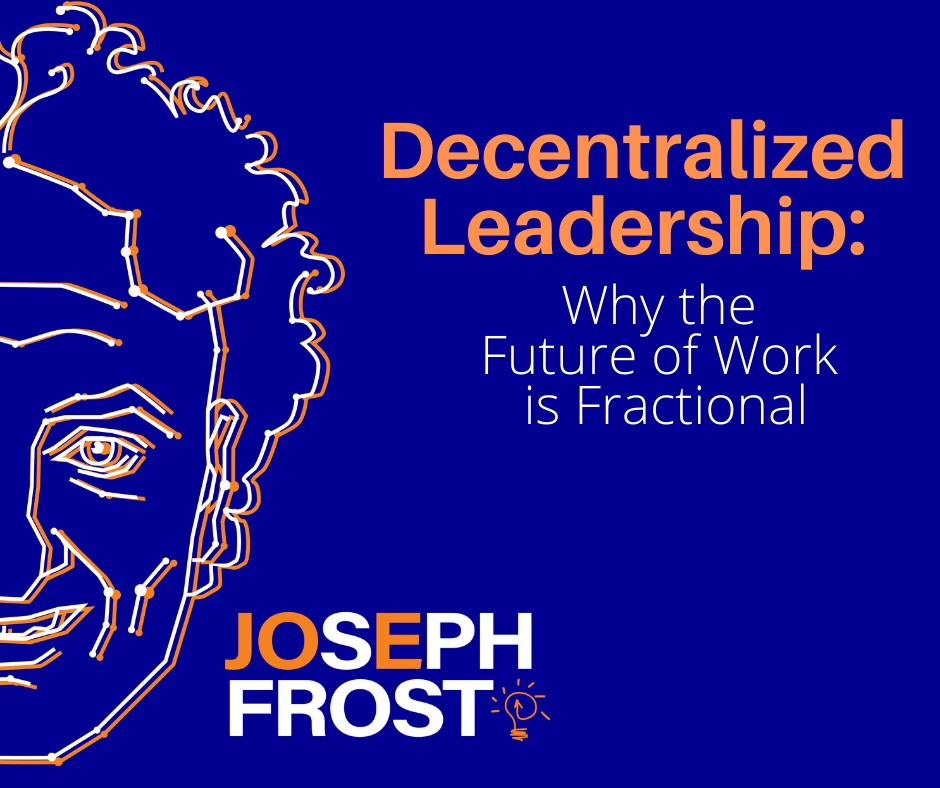The world is changing faster than it ever has. Out of those changes emerges a new model of decentralized leadership: fractional.
“Fractional” leadership inherently implies a definition that is easily understood: an executive leader joins an organization on a flexible, part-time, basis, spending a fraction of the time of a full-time leader and comes at a fraction of the cost.
However, the term “fractional” also implies smallness, fragmentation, incompletion. Leaders joining an organization in a fractional capacity are anything but small or fragmented – and neither is the impact they bring to a growing company. We knew there was a better way of defining the model.
To re-evaluate the leadership and hiring model of the future, we started by understanding what leadership of the future looked like. Modern leadership would:
- Relinquish centralized control of knowledge
- Always lead with empathy & transparency rather than authority
- Encourage flexibility
- Understand, embrace & prepare for the future of work
- Leverage external expertise & believe in the power of community
The model for modern leadership looked familiar. We saw an opportunity to re-evaluate the fractional concept through a deeper lens. The “fractional” business model is, in reality, decentralized.
Inspired by Blockchain
You don’t need to be a Blockchain expert to know that decentralization as a concept has gained traction rapidly. While Blockchain may have popularized the concept, a new definition for decentralization is developing in the context of the future of work – one which had not been applied previously. From our view, decentralization is not only tangential to but entirely essential to the future of work.
Re-evaluating the fractional concept by means of decentralization brings the model closer to a more authentic reality – one which reflected (almost eerily-so) the future of modern leadership.
At its core, Blockchain:
- Eliminates aggregated central control
- Is rooted in outsourcing
- Facilitates P2P (peer-to-peer) engagement
- Is dependant on network dynamics
- Bolsters flexibility & independence
- Creates a paradigm shift in business models & revenue creation
Ultimately, we realized the fractional model is a decentralized one. Like Blockchain principles, a decentralized hiring model seeks to transfer power and authority to lower levels of an organization, flattening hierarchies and creating a deeper sense of equality and interdependence, rather than authority, between leaders and teams. In a decentralized model, knowledge ripples across an organization, silos are eliminated and leaders are connected to teams in a real way.
But before diving into the ways in which decentralized leadership can ignite an organization’s future, let’s take a brief look to the past.
A Brief History of Decentralization
Historically, “decentralization” has been used as a political term signifying a reduction in the authority of national governments over policymaking. The Center for International Earth Science Information Network (CIESIN) of Columbia University, for example, defines decentralization as “the transfer of part of the powers of the central government to regional or local authorities.” CIESIN argues that decentralization in governance is a by-product of local governments and civil society wanting to be more involved in the managing their own local affairs.
In more recent years, decentralization has come to be attached to decision-making. Peoplehum, a HR technology platform, defines decentralization as the “specific form of organizational structure where the top management delegates decision-making responsibilities and daily operations to middle and lower subordinates.” By transferring decision-making responsibilities, the C-Suite is left with more time, energy and focus to grappling with strategic decision-making which affects the organization as a whole. While decentralized leadership does impact decision-making structures within an organization, its impact goes far beyond decision architecture.
Once decentralization became embraced by Blockchain, its definition took on an altogether expanded meaning – one that would bring it squarely into the future.
MIT’s Journal of Design and Science (JoDS) suggests that, because “blockchains are not controlled by a central authority, but by the entire network of participants, who establish the rules for participation themselves and can elect to evolve the system according to consensus,” Blockchain offers an alternative to Silicon Valley’s monopolized technological development. Again and again, decentralization as a concept is defined as the transferring of centralized powers into more local or subordinate actors in the context of hierarchies. It is an egalitarian and democratic philosophy – but how does it apply to leadership, to small businesses, to entrepreneurs and to the future of the workplace?
Future of Work
The future of work is here – and it looks entirely different than average businesses, small or large, have been used to.
A record 4.3 million Americans quit their jobs in one month in 2021 (December). Recent research shows that more than 40% of the global workforce are considering leaving their employers this year. As resignations rise, alternative models for working are gaining traction – rapidly.
Over the next five years, 52% of the U.S. adult workforce will either be working or will have worked as an independent contributor. 63% of full-time executives confirmed they would become an independent contractor, given the opportunity. The consulting, independent & fractional economy is one of the fastest-growing phenomena in the country.
According to an Intuit 2020 report, 80% of US companies plan to use a flexible, non-traditional workforce. Likewise, Harvard Business Review has reported that approximately 150 million people in the US and Western Europe currently work as independent contractors.
In a post-pandemic world of work, the “Great Resignation” continues to transform the way companies operate. As technology continues to usher in new ways to run our companies, one thing has become clear: the leadership model of the future is decentralized.
However, the “Great Resignation” can also become our greatest opportunity.
After a mass exodus of leaders and teams from traditional employment structures, a new period in economic history is set to begin: the “Great Rehire” – though it will look radically different from what traditional hiring has looked like. A decentralized leadership model values flexibility, relinquishes centralized control structures, and brings more objectivity, freshness of perspective, and creative ideation – and it is set to transform the post-pandemic workplace.
Benefits of Decentralization
Decentralized hiring models for leadership hold numerous benefits – and the organizations already employing the model are seeing major returns across productivity, culture and governance pillars within their organizations.
Diversity of Thought
Decentralized hiring, the strategic implementation of fractional and part-time leaders within the C-Suite, is non geo-centric: in a remote-first world of work, organizations have access to a broader and more diverse talent pool to scale their teams.
With traditional geographic boundaries eliminated from the equation, organizations have more options to bring specific, niche expertise from across their industry or outside of their industry. Expertise within the organization can reach new heights, and diversity is driven up, both in terms of cultural background and in terms of thought. Hidden biases stemming from an entirely-local talent pool which often make their way into traditional hiring practices, like conformity bias (also called “Groupthink”), are quickly
eradicated.
A Culture of Decision-Making
Decentralized leaders are often only physically (or virtually) present a fraction of the average work week. As a result, a culture of decentralization becomes a culture of decision-making: mid-level teams become empowered to own their own decision-making capabilities without the necessity of turning to a direct ever-present leader for continuous streams of approvals. As a result, with time, teams become more autonomous and more productive. Likely, teams that own their own decision-making will also see an increase sense of happiness and satisfaction in their role. It’s been said that “meaning is the new money”: if 9 out of 10 people are willing to earn less money to do more meaningful work, the companies of tomorrow are incentivized to ensure meaning, autonomy, and satisfaction are core to daily operational culture.
As a result of a shift in decision-making hierarchies, the C-Suite becomes liberated, with a lesser cognitive load and more time to focus on strategic planning (which, arguably, increases their own satisfaction with their role). Micro-management is systematized out, by design; strategic and critical thinking is systematized in.
Embracing Equity
Decentralization fosters a more equitable culture by flattening an organization’s structure. Fractional executives who, coming in as part-time or independent leaders, often bring a genuine, deep enthusiasm to a company’s success – one that is entirely different from the traditional employer-employee work dynamic. Suddenly, an external leader coming internally to an organization develops a deep commitment to the company’s mission, vision, values and big goals.
The paradigm shift from “You work for me” to “I work for me and you,” interlinking each person’s success, creates an environment where all employees and leaders share common objectives and aligned incentives. Teams feel more supported instead of less – and a strong sense of belonging is created. Power dynamics shift when aggregated control centers, as with Blockchain, are eliminated.
Ultimately, decentralized work environments are empowered ones where employees can make their own decisions in local matters, empowering them to take higher ownership over their role. Ownership and leadership teams benefit from heightened efficiency, speedier decision-making, increased adaptability, and a more egalitarian and diverse work culture. Organizations become more creative, save more costs, are infused with more energy, have access to talent and ideas they would not normally have access to, and become more flexible in a way that traditional corporate structures simply cannot be.
The fractional leadership model is a decentralized one – and it can be adapted seamlessly for smaller, founder-run organizations or larger, C-Suite-run organizations equally.
Implementing Decentralized Leadership
The benefits of the decentralized, fractional model are clear – and the next step is implementation. Key questions remain, including:
- How can entrepreneurs implement the power of fractional professionals to prepare for the future of work?
- How can we leverage it to create kinetic energy that attracts high-calibre prospective clients and employees?
- How can a fractional, decentralized model for hiring leaders help our organizations combust at scale?
Nobody knows with certainty what the business world of tomorrow will look like. Yet, one thing is clear: as the world continues to evolve and transform rapidly, it is our role as entrepreneurs and leaders to prepare as best we can for what the future will hold for ourselves and for our organizations.
A Seth Godin famously said: “Change almost never fails because it’s too early. It almost always fails because it’s too late.”
——
Joseph Frost is a Decentralized Entrepreneur, University Professor of Entrepreneurship & 3X Founder. He is the Founder of yorCMO, the first Decentralized Leadership franchise business, and is the head of the Fractional Professionals Association, the first & only community for decentralized, fractional executives & leaders looking to join the future of work. He is also the host of the weekly podcast “The Fractional C-Suite Retreat.”


